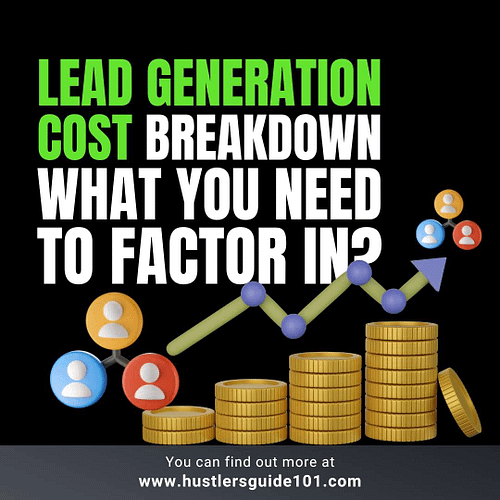
Do you find yourself asking questions like: “How much does lead generation cost?” or “How to maximize the effectiveness of lead generation channels?” If so, you’re not alone!
The truth is, lead generation costs can vary greatly depending on your business goals, target audience, and marketing strategies. And with so many different factors to consider, it can be overwhelming to know where to start.
But don’t worry! That’s where this blog comes in. We’re here to help you understand the ins and outs of lead generation costs, so you can make informed decisions about how to allocate your marketing budget.
By the end of this blog, you’ll have a clear understanding of the different costs associated with lead generation, and how you can optimize your budget to get the best results for your business.
Understanding the Cost of Lead Generation
When it comes to lead generation, understanding the cost is key. But what exactly do we mean by “cost”? In simple terms, cost refers to the money or resources you’ll need to invest in order to generate leads for your business. It’s important to note that there are both fixed and variable costs associated with lead generation.
Fixed costs
Fixed costs refer to expenses that remain constant, regardless of the number of leads generated. For example, the cost of your website or the monthly fee for your CRM software would be considered fixed costs.
Variable costs
Variable costs, on the other hand, are expenses that vary based on the number of leads generated. This can include the cost of advertising, email marketing campaigns, or the salary of your lead generation team.
Importance of Budgeting for Lead Generation
When it comes to lead generation, budgeting is key. Without a clear understanding of your costs and resources, it can be difficult to measure the success of your efforts and make informed decisions about your strategy.
Think about it – without a budget, you won’t know how much you can afford to spend on advertising and marketing, or how much you need to allocate to different channels and campaigns. This can make it challenging to get the results you want and effectively measure the ROI of your lead generation efforts.
But here’s the good news – budgeting for lead generation doesn’t have to be a headache! With a little bit of planning and forethought, you can develop a budget that will help you achieve your goals and maximize your results.
Start by considering the factors that can impact your lead generation costs. Then, use this information to set realistic goals and allocate your budget in a way that makes sense for your business.
It’s also important to be flexible with your budget – as your lead generation strategy evolves over time, you may need to adjust your budget to reflect changes in the market or your target audience. The ability to adapt and be flexible is crucial to staying ahead of the curve and achieving success with your lead generation efforts.
Additionally, tracking your expenses and measuring the results of your lead generation efforts can help you make informed decisions about where to allocate your budget moving forward. This can help you identify areas that are working well and areas that need improvement, so you can adjust your strategy accordingly.
Factors that Affect Lead Generation Costs
When it comes to lead generation, there are a number of factors that can impact the cost. Let’s take a closer look at some of the key factors that you should consider when estimating your lead generation expenses.
1. Size of target audience:
The larger your target audience, the more you’ll need to spend on advertising and marketing efforts to reach them, which can increase the cost of lead generation.
2. Competition for the target audience:
If you’re in a highly competitive industry, you’ll need to allocate more budget towards lead generation to stand out from the crowd, which can increase costs.
3. Quality of lead generation efforts:
High-quality leads typically result in higher conversion rates and lower cost per lead, while low-quality leads can result in lower conversion rates and higher cost per lead.
4. Methods chosen for generating leads:
Certain lead generation methods, such as paid advertising, can be more expensive than others, such as content marketing, which can affect the overall cost of lead generation.
5. Industry and market trends:
Industry trends and market conditions can impact the cost of lead generation, as some channels may become more or less effective over time.
6. Location and target audience demographics:
The location and demographic of your target audience can affect the cost of lead generation, as certain regions and audiences may be more expensive to reach than others.
7. Objectives and desired results:
The specific goals and desired results of your lead generation efforts can affect the cost, as some strategies may require more resources or investment to achieve desired outcomes.
8. Resources available:
The size of your team and access to technology can impact the cost of lead generation, as additional personnel or technology may be necessary to execute certain strategies.
9. Integration with other marketing and sales efforts:
Integrating lead generation with other marketing and sales efforts can streamline processes and maximize results, but can also increase the overall cost.
10. Flexibility and scalability of lead generation efforts:
The ability to adjust and scale lead generation efforts can help you stay ahead of changes in the market and achieve desired results, but can also increase the cost if additional resources are needed.
Lead Generation Channels and their cost
As you can see, the cost of lead generation can add up quickly, especially if you’re using a variety of channels and strategies. That’s why it’s essential to have a clear understanding of the costs involved, so you can make informed decisions about how to allocate your budget.
Stay tuned for more insights on lead generation costs in this blog!
Channel #1: Paid Advertising
The average lead generation cost for paid advertising is 63$ per lead.
The paid advertising involves placing ads on search engines like Google and Bing. The cost of paid search can range from a few cents to several dollars per click, depending on the competition for the keywords you’re targeting.
One of the biggest benefits of paid search is that it can deliver results quickly, making it a great option for businesses that need to generate leads fast. However, it’s important to have a clear strategy in place and to track your results to ensure that you’re getting a good return on investment.
Channel #2: Content Marketing
The average lead generation cost for content marketing is $92 per lead.
Content marketing involves creating valuable content, such as blog posts, infographics, and videos that can attract leads and build your brand. The upfront cost of creating content can be high, but the long-term benefits can make it a cost-effective lead generation channel.
The key to success with content marketing is to create content that provides real value to your target audience and to promote it through channels like email, social media, and paid search.
Channel #3: Email Marketing
The average lead generation cost for email marketing is $53 per lead.
The cost of email marketing can vary based on the size of your email list and the frequency of your campaigns. For example, sending a weekly newsletter to a list of 10,000 subscribers will likely cost more than sending a monthly newsletter to the same list.
The key to success with email marketing is to segment your list based on the interests of your subscribers and to send them relevant, targeted content.
Channel #4: Social Media Marketing
The average lead generation cost for social media marketing is $58 per lead.
Social media is a cost-effective way to reach a large audience and generate leads. The cost of advertising on social media can vary widely depending on the platform you choose, the targeting options you select, and the competition for ad space.
For example, Facebook advertising can be relatively cheap, while LinkedIn advertising can be more expensive due to its business-focused audience. The key to success with social media is to know your target audience and to create ads that resonate with them.
Channel #5: Referral Marketing
The average lead generation cost for referral marketing is $73 per lead.
Referral marketing involves encouraging existing customers to refer new leads to your business. This can be done through incentives, such as discounts or referral bonuses, or through a referral program.
The cost of referral marketing can vary depending on the incentives you offer, but it can be a cost-effective way to generate leads since the cost per lead is often lower than with other lead generation channels. The key to success with referral marketing is to make it easy for your customers to refer leads, and to provide them with a clear incentive to do so.
Channel #6: Events and Trade Shows
The average lead generation cost for email marketing is $811 per lead.
Attending events and trade shows can be a great way to meet potential leads in person and build relationships. However, the cost of attending events can be high, including expenses for travel, accommodations, and booth fees.
The key to success with events and trade shows is to choose events that are relevant to your target audience and to have a clear plan for follow-up after the event.
Note: You can also outsource lead generation. To know how, check here.
Optimizing Lead Generation Costs
Optimizing lead generation costs is critical to the success of any business. The goal is to generate leads at the lowest possible cost while still achieving high-quality results.
By taking the time to analyze your current efforts, invest in proven methods, and track your progress, you can generate leads at the lowest possible cost while still achieving high-quality results.
In this section, we’ll explore some best practices for cost optimization, the impact of lead quality on lead generation costs, and the role of technology in optimizing lead generation efforts.
Best Practices for Cost Optimization
- Conduct a thorough analysis of your current lead generation efforts to identify areas where you can reduce costs.
- Utilize multiple lead generation channels to diversify your efforts and reduce risk.
- Invest in lead generation methods that are proven to be effective, such as content marketing or email marketing.
- Use data and analytics to track the performance of your lead generation efforts and make informed decisions about where to allocate your budget.
Impact of Lead Quality on Lead Generation Costs
- High-quality leads are more likely to convert into customers, making them a more valuable investment in the long run.
- Poor-quality leads can be costly to generate and may not result in conversions, making it important to focus on lead quality when optimizing your lead generation costs.
The Role of Technology in Optimizing Lead Generation Costs
- The use of technology, such as marketing automation tools, can streamline lead generation efforts and reduce costs.
- Advanced analytics tools can help you track the performance of your lead generation efforts and make data-driven decisions about your strategy.
How much does lead generation cost? – Hot FAQs
What is the average cost per lead for lead generation?
The average cost per lead can vary greatly depending on the industry, target audience, and lead generation channel. On average, the cost per lead can range anywhere from $10 to $100 or more.
It’s important to understand the costs involved in your specific lead generation efforts and to set a budget that allows you to generate leads effectively without overspending.
How does the size of my business affect lead generation costs?
The size of your business can have a significant impact on lead generation costs. Smaller businesses may have limited budgets for lead generation and may need to focus on more cost-effective channels such as referrals or content marketing.
Larger businesses, on the other hand, may have more resources available for lead generation and may be able to invest more in channels such as PPC advertising or trade shows.
Can I generate leads for free?
While it is possible to generate leads for free, it can be time-consuming and may not provide the same results as paid lead generation efforts. Cost-effective options, such as content marketing or referrals, can help generate leads without significant investment, but paid channels such as PPC advertising or email marketing can often generate leads more quickly and effectively.
How does lead quality impact lead generation costs?
Lead quality can have a major impact on lead generation costs. Lower quality leads may not convert as well and may require more time and resources to nurture, resulting in higher overall costs. By focusing on high-quality leads, you can lower your lead generation costs and improve your return on investment.
How can I optimize lead generation costs?
There are several strategies that can help optimize lead generation costs, including setting a budget, focusing on cost-effective channels, and improving lead quality.
It’s also important to regularly analyze and adjust your lead generation strategy to ensure you’re getting the best return on investment. The use of technology, such as marketing automation software, can also help optimize lead generation efforts and reduce costs.
Wrapping up
Keep in mind that the cost of lead generation is an investment in your business, and the right approach can pay off in the form of increased conversions and sales.
So, whether you’re just starting out or looking to refine your existing lead generation strategy, take the time to evaluate the factors that can impact your costs and develop a plan that will help you achieve your goals and maximize your results.
By following the factors regarding how much does lead generation cost, you can ensure that you’re making the most of your lead generation efforts and seeing real, tangible results for your business. So, don’t wait any longer – start optimizing your lead generation today!







